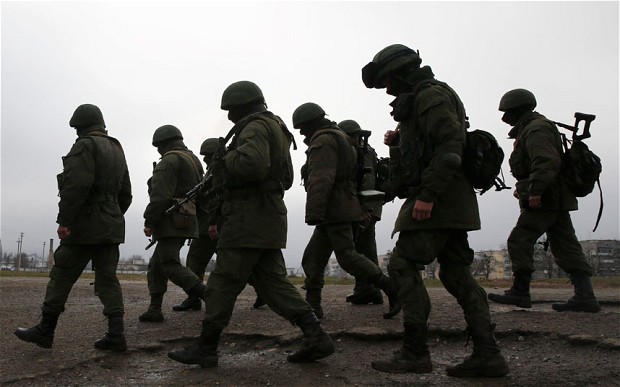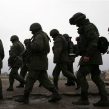
Conserved Conflict: Russia’s Pattern in Ukraine’s East
Publication: Eurasia Daily Monitor Volume: 12 Issue: 226
By:

Russia’s military intervention in Ukraine’s east—directly and by proxy—has saddled Ukraine with a “frozen” conflict in its Donetsk and Luhansk provinces. The parallel situation in Crimea also qualifies as a “frozen conflict,” insofar as Russia’s forcible annexation is not recognized internationally, and in that sense the peninsula has no valid status. These are the latest in the series of conflicts initiated or abetted by Russia against its neighbors, but Western powers have yet to grasp the operating patterns and to respond adequately.
The inadequacy of that response begins with the terminology. Thus, the value-neutral, equidistant term “conflict” averts naming Russia (directly or via its protégés) as the aggressor party or occupier of the territory. A conflict “freeze” would suggest a natural, spontaneous process, whereas it might better be described as conflict-conservation, designed to relegate the situation to quasi-oblivion and leaving Russia the winner on the ground. It is a reflection on the inadequacy of the “frozen conflict” stereotype that this and associated terms are accompanied sometimes by semi-apologetic inverted commas.
Compared with the predecessor cases, Russia’s conflict undertaking in Ukraine’s east has had by far the most destructive impact in terms of battle theater size, population numbers directly affected (at least four times larger than the populations of Transnistria, Abkhazia, South Ossetia, and Karabakh taken together), numbers of internally displaced persons and refugees (possibly ten times the combined numbers in those predecessor, unresolved cases), high-intensity firepower (heavy artillery, multiple-launcher missile systems), damage to fixed assets in Ukraine’s most heavily industrialized area, and Ukrainian battlefield casualties (approximately 9,000 killed in action within 18 months—a higher casualty rate by comparison with those predecessor cases).
Military hostilities in Ukraine’s east are currently giving way to the phase of conflict conservation. Its characteristics, fitting within the broad pattern (see above), include:
- Suspension of active military operations, albeit under threat of their resumption by the stronger side (Russia with its proxies in this case);
- Establishment of military demarcation lines on the ground, with a potential to turn into political demarcations;
- The “conflict” is deemed to involve local belligerents—Ukraine versus Donetsk-Luhansk. This subterfuge allows Western governments and organizations to avoid designating Russia as aggressor or at least a belligerent. The West (collectively, more or less) does acknowledge the fact of Russia’s military presence and its illegitimate character, and does call for the withdrawal of Russian troops or protégés. But such calls bring little or no results over years or decades (since the early 1990s in the cases of Transnistria, Abkhazia, South Ossetia or Karabakh). In the case of Donetsk-Luhansk, “foreign” forces and their local recruits are so combined as to make it hard to distinguish between them.
- International formats of negotiation are mainly designed to promote “de-escalation” of hostilities, draw stable demarcation lines, and oversee negotiations between the local parties to the conflict. These are deemed to be the legitimate government of the aggressed country and the de facto authorities in the occupied territory. Although Russia is a belligerent party (indeed the conflict’s initiator), Moscow at the same time plays the role of mediator between Kyiv and Donetsk-Luhansk in the Minsk Contact Group, and the role of overseeing the political settlement as part of the “Normandy” Group.
- The Organization for Security and Cooperation in Europe (OSCE) is mandated to oversee the observance of the armistice, by consensus between Russia and the Western powers within the OSCE. This plays into Russia’s hands by dint of its veto power on the OSCE mission’s mandate, down to the technical details of its equipment and access rights. This is a repeat of Russia’s cat-and-mouse play with the OSCE’s missions in Georgia, only on a larger scale in Ukraine (some OSCE officials have undergone that experience in both countries). Monitoring and verification of compliance with the armistice is less than reliable in the Russian-controlled territory. This makes it possible for Russian and proxy forces to generate threats of surprise attacks against Ukrainian positions, so as to keep the Ukrainian side off-balance and insecure. This situation cannot but affect the diplomatic process.
- The diplomatic process leads toward international acceptance of authorities in Russian-controlled territories as de facto interlocutors. The goal of conflict-conservation necessitates those authorities’ cooperation as well as Russia’s: at first, for de-escalation and creation of buffer zones; eventually, for seeking a political settlement with Russia and its local protégés. The political settlement is an elusive process, long-term at best. To advance it, Western powers and Russia promote confidence-building measures (military, economic, political) between the country’s central government and Russia’s local protégés. This endeavor tends to equalize the legitimate government and those unrecognized local authorities in practical terms as parties to the conflict-resolution process. Two possible pitfalls wait along this way: either confidence-building measures substituting for conflict-settlement, i.e. a “freeze;” or the creeping legitimization of the Russian-controlled local authorities and their empowerment in the eventual settlement.
Western powers, as a rule, are eager to reduce their engagement soon after the prerequisites to conflict-conservation have been laid. Higher priorities elsewhere absorb far larger shares of Western resources and attention. Those higher interests can supposedly be advanced with Russia’s cooperation; the “We need Russia” mentality (whether on Afghanistan, Iran, anti-terrorism, Syria) takes over, as seen recurrently in the last 10 to 15 years. With the passage of time, the conserved conflicts are relegated to ever-lower rungs on the scale of Western priorities. This sets the stage for an undeclared acceptance of what Russia declares to be “new realities” on the ground. The dynamics in Ukraine’s east, however, have not reached that stage as yet.
Beyond these recognizable patterns, however, Russia’s conflict undertaking in Ukraine’s east involves a number of major political and military innovations.




